|
LEM144 DXpedition Report
December 2-10, 2000
by Mika Mäkeläinen
The highlight of the DX-year:
a trip to Lapland in search of tiny, remote, unknown
broadcasting stations... However, under conditions
of high solar activity (and lower media activity
than on LEM132 in 1999)
we didn't hold very high expectations of this DXpedition
to the Arctic DXing paradise.
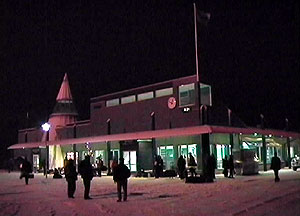 |
| Kolari railway station |
We figured that timing the DXpedition
near the darkest time of the year should nevertheless
provide an almost 24-hour flow of radio stations
from at least some direction no matter how turbulent
the conditions would be.
This proved to be the case towards
the end of the DXpedition as conditions improved
gradually over the week, but in the beginning midday
was a dead period in terms of acvitity on the dial.
Overall we were satisfied with the results. Even
though we caught only few stations from North America,
we did have some nice openings to other continents.
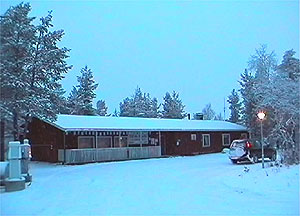 |
| Tieva bar in the village of
Pokka |
We, Jim
Solatie and Mika
Mäkeläinen, set off to Lemmenjoki
on Friday evening December 1st at the Helsinki railway
station, taking the overnight train to Kolari, the
northernmost railway station in the country.
Jim drove his Honda on the train,
and just before departure we met at McDonalds for
the last hamburger in over than a week. More than
the rattling of the train, excitement over the upcoming
week kept us awake part of the following night.
After arrival, just like
the year before, we stocked groceries and enjoyed
a pizza in nearby Kittilä. At these latitutes,
my favorite is the local reindeer pizza.
After passing the Tieva
bar in the village of Pokka, we were again on our
own as far as cooking goes, which in theory would
have been an ideal chance to lose a few kilos. However,
as my daily bread was the self-designed graveyarder
sandwich - consisting of salami, onion and a
lot of cheese on rye bread - the much-needed calory
deprivation remained an even more elusive goal than
good propagation conditions.
Asians heard on
arrival
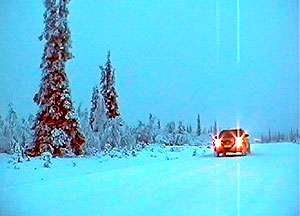 |
| Lemmenjoki here we come! |
We arrived in Lemmenjoki before
2 p.m. local time on Saturday December 2nd. The
previous DXpeditionists, Jyrki Hytönen and
Markus Salonen on LEM143, had left a few hours earlier
after a week of poor reception conditions.
As the antennae were already
up, it didn't take more than an hour to set up our
gear and start scanning the dial. Transatlantic
signals were non-existent, which wasn't much of
a surprise, as LEM143 hadn't identified a single
U.S. station during the entire week.
LEM144 was the 6th DXpedition
of the season to Lemmenjoki. This year antennae
remained the same as before. More on our equipment
here.
A few Asian stations were audible
immediately as we switched our radios on. Just like
the previous year, we expected good catches from
South-East Asia, which should not be so severely
affected by geomagnetic instability - and many of
our best catches were indeed from Asia.
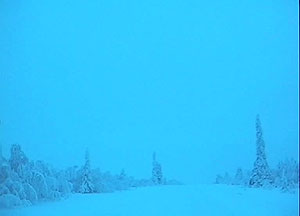 |
| A typical scene at "daylight".
Yes, there's a road somewhere in the middle. |
During the first few days Asian
AM stations faded in rather late, around 1200-1300
UTC, and very soon stations from India, Iran and
the Middle East - and even Europeans - overpowered
any Far-East signals. Exceptions were the upper
band powerhouses; China on 1593 kHz, Thailand on
1575 kHz, South Korea on 1566 kHz and Taiwan on
1557 kHz, as well as other powerful Taiwanese stations,
which came loud and clear for hours nearly every
day.
On Monday Dec. 4th during otherwise
lousy conditions I picked up Radio Pakistan on 1260
kHz, unlisted and previously unheard in Finland.
On Tuesday Dec. 5th conditions to India were excellent
with AIR stations dominating on 1602 kHz for 2,5
hours, something I had never experienced before.
The same evening stations from the Far East made
a surprising comeback after 1800 UTC, and I was
able to identify for example DZXL under a 50-kilowatt
Finnish station on 558 kHz.
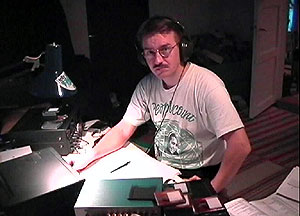 |
| Mika on the hunt |
On Wednesday Dec. 6th Malaysia
surfaced on 1475 kHz around 1125 UTC, so I knew
to hunt for Australian X-band stations, and eventually
heard a few - the first time ever for me.
On Thursday, some Chinese
stations were very briefly audible around 0930 UTC,
but disappeared soon - until some Philippino stations
were heard after 1130 UTC. Conditions improved gradually,
and on Friday Dec. 8th Chinese stations came through
already before 1100 UTC. Finally on Saturday December
9th we heard our first Japanese stations already
after 1000 UTC, and this became our most rewarding
afternoon with several interesting Japanese, Chinese
and Philippino stations logged.
Romania and Ramadan
Turning to our own continent,
we tried to find new stations especially from the
Balkans. On Sunday, Dec. 3rd, Jim heard an interesting
station on a variable frequency around 1605 kHz.
I reported it on Monday. At the time we thought
the ID sounded like "Radio Sudet", but
it proved to be Radio Sud Est from Slobozia in Romania,
a totally unknown station among hobbyists and definitely
one of the highlights of the DXpedition. On Monday,
Dec. 4th, we picked up Radio Berovo from Macedonia
on 1485 kHz, another top class logging from the
region. Local breaks yielded a few catches from
Spain, Italy and Greece, but otherwise we didn't
have much interest in Europe.
 |
| Remember the -52 degrees?
Naturally it was too hot for Jim inside... |
While Ramadan had filled the
wee-hours with stations from Iran, the Middle East
and even North Africa, it seemed to have an adverse
effect on their habits of identifying, and especially
local station identifications were few. From the
rest of Africa, only the Canary Islands are worth
mentioning, as we noted a very short and sharp peak
to the area at 0655 UTC on two mornings. It was
also the only time to hear stations from Morocco
and Portugal.
Moving over to the Americas,
North American stations made only a brief appearance
daily around 0700-0800 UTC. On Sunday, December
10th, U.S. stations remained on the dial when we
pulled the plugs at 1006 UTC, so it seems that conditions
were definitely improving just as we had to leave.
Typical luck.
 |
| Haute cuisine |
We heard nothing worth mentioning
from Central America, but fortunately conditions
to South America were somewhat better than on our
DXpeditions during the past few years. During the
first half only the most common Brazilians were
heard during the night, but on the morning of Wednesday,
Dec. 6th, a few Venezuelans and Colombians were
identified. On Friday and Saturday conditions to
the La Plata region improved, and some stations
from that general area were audible all the way
until 0730 UTC. Then on Saturday after 0030 UTC
stations from Argentina and Uruguay came very well,
and we were especially pleased to hear other X-band
stations aside from 1620 and 1630, which are relatively
common. A special case was Radio Boanerges from
Posadas on 1640 kHz, which had never before been
detected by DXers anywhere, not even in Argentina.
It should also be noted that
very often under disturbed conditions shortwave
reception in Lemmenjoki is close to impossible,
but this time we were able to listen to some tropical
band stations from Latin America, Asia and Papua
New Guinea with surprisingly strong signals, so
in daytime much of our time was spent on the shortwave
band.
From sleet to
freeze
At this time of the year Lapland
should already rest under thick snow, but on arrival
the ground was barely covered. This made checking
the antennae easier than ever before in mid-winter.
For the rest of the week the weather remained moderate,
with occasional rain and snowshowers, and temperatures
from above freezing point down to -23 degrees Celsius
or -10 degrees Fahrenheit. One evening, under clear
skies (an exception), we witnessed very beautiful
northern lights in rapid movement and changing colors.
With propagation conditions already less than ideal,
this magnetic performance didn't seem to have any
effect on the dial.
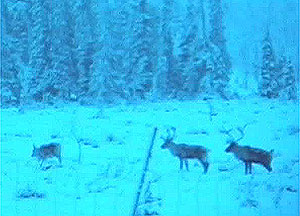 |
| Reindeer as visitors see them |
We weren't able to get return
train tickets for Saturday as planned, so we decided
to extend the DXpedition for one day, after which
Alpo Heinonen arrived in Lemmenjoki to take over
for the next week.
Returning to the McWorld on Sunday
afternoon, we had a snack at the northernmost McDonald's
in the world, in the town of Rovaniemi on the Arctic
Circle, and took the overnight train back south.
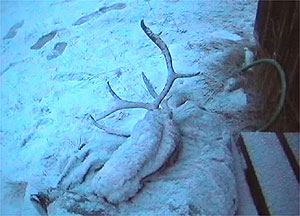 |
| Reindeer as locals see them |
So when exactly did we sleep?
Often we hit the sack around 1800-1900 UTC sleeping
until at least either one woke up around 2300 UTC.
If the night was poor, we took turns in scouting
the dial. Most nights both were able to sleep again
at roughly 0300-0500 UTC without missing anything.
Periods at 0600-0800 (for the Western hemisphere)
and 1200-1400 UTC (for the Eastern hemisphere) were
the most intense DXing sessions.
Finally, for details on the identified
stations, here's the LEM144
DXpedition log. I hope that our practise of
sharing the catch by publishing our findings before
sending out reception reports would encourage others
to do the same. For some logging guidelines, check
out notes on the log.
Initially only Mika's loggings were included, and
Jim's stations were added a week later.
Posted on December
17th 2000, last edited on December 27th 2001
  
|